While humans take years to mature, dogs seem like they mature in an instant. All you would remember is bringing home an adorable little puppy, and before you know it, he/she will have developed, displaying behavioral changes like a teenager!
Like any other developmental stage in dogs, sexual maturity is also a natural and equally important process, and to be a responsible dog owner, you need to understand the same to make sure that your puppy is healthy and happy.
In this article, you will learn about:
- 10 Signs that a male dog wants to mate.
- 10 Signs that a female dog wants to mate.
- Sexual behavior in male & female dogs.
- How to calm a male & female dog in heat
- And more…
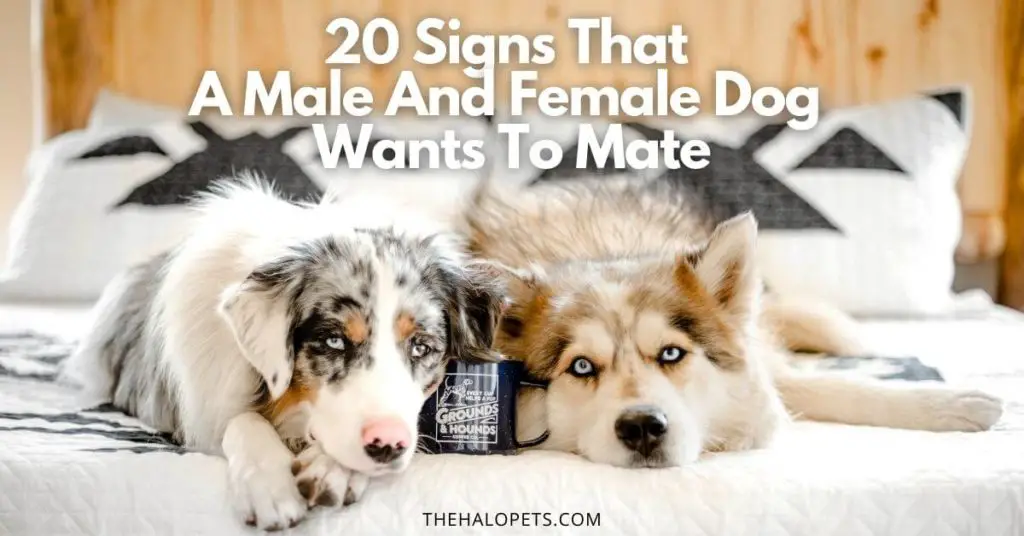
When Do Puppies Become Sexually Mature?
The answer to this question mainly depends on the puppies’ breed and size. According to American Kennel Club, puppies become sexually mature usually between 6 and 9 months of age. However, for some giant breeds, it could take longer to attain sexual maturity.
Sexual Behaviors In Male Dogs
Did you know that male dogs (in most species) have a testosterone surge within just a few days after their birth? This happens to masculinize their brain.
Also, male puppies display behaviors like mounting and thrusting as early as 3 to 6 weeks after birth; but, these behaviors are rather playful than sexual.
It is important for dog owners to note that depriving male puppies of these playful behaviors can have an adverse effect on their mating behaviors as adult dogs.
While dogs, in general, attain puberty between the ages of 6 and 18 months, it happens a bit later for males than females.
And when male dogs attain puberty, they tend to display behaviors pertinent to sexual dimorphism, which differentiates them from females. These behaviors include raised-leg urination, and sexual mounting and thrusting.
Furthermore, during puberty, male dogs exhibit other masculine behaviors like territorial defense, aggression towards other dogs, and dominance over their owners.
Male dogs are also considered to be promiscuous when it comes to mating and are highly receptive to female dogs that are in heat (estrous) during any time of the year.
Sexual Behaviors In Female Dogs
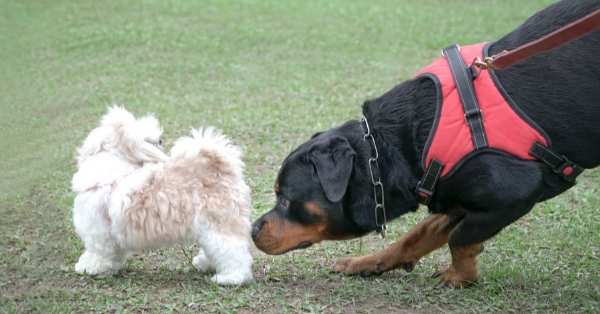
While a testosterone surge happens in male pups to enable their male characteristics to develop, the same does not happen in female puppies, which results in their brains developing female traits.
Just like the sexually dimorphic behaviors displayed by male dogs, female dogs also display pertinent behaviors like seeking more attention, being easy to housebreak, and being easy to train.
Female dogs generally attain puberty between 6 and 9 months of age. Of course, it differs based on the breed and size of the dog.
Also Read: What To Expect From A Female Dog After Mating?
Do Female Dogs Go Into Heat?
According to The People’s Dispensary for Sick Animals, a heat cycle refers to the period when a female dog is fertile and the chances of her getting pregnant are high.
When it comes to a dog’s heat cycle, there are typically four stages, as described by the East Central Veterinary Hospital. These are:
Proestrus
Proestrus is the initial or starting stage of a female dog’s heating cycle and typically signifies that her body is getting ready to mate. This stage can last for up to 27 days, with an average of 9 days. It is during the proestrus stage that a dog owner will start to notice changes like:
- Swollen vulva
- Clingy behavior
- Blood tinged vaginal discharge
- Excessive licking of genitals
- Aggression towards male dogs
When your female dog is in her proestrus stage, male dogs will start feeling an attraction towards her; however, she will not be readily receptive at this stage of her heat cycle.
Estrus
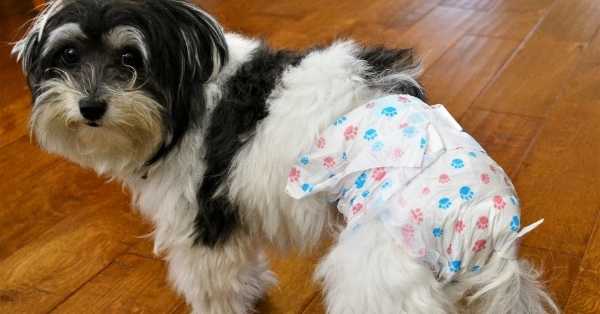
It is during this stage that a female dog will become receptive to male dogs’ approach for mating. This is the female’s fertile period and can last for an average of 9 days, but the time frame typically ranges between 4 and 24 days.
Your female dog is likely to be urinating more frequently than usual, which is her way of marking spots to let male dogs know that she is ready to mate.
During this time, her progesterone levels will increase with a steady decrease in estrogen levels. Her vulva will be enlarged, but the bloody discharge will have reduced.
Also, a female dog in the estrus stage will have low to no aggression towards male dogs, but some females might be aggressive towards other female dogs. If there is a male dog in the vicinity, she is more likely to approach him.
Diestrus
When this stage starts, it is an indication that your female dog is out of her fertile period or heat phase, which means she will no longer be receptive to approaching males.
Lasting for about 2 whole months, the diestrus stage is when the female dog’s body will get back to its normal self, with the swelling of her vulva reducing, vaginal discharge stopping, etc., or she will become pregnant.
The female’s behavior towards male dogs will be casual, neither aggressive nor welcoming or friendly, and so will be her behavior toward other female dogs.
Anestrus
After the diestrus stage, there will be a long gap of 4 months (longer for some breeds) until the start of the next heat cycle or proestrus; this time period is called the anestrus stage.
During this time, your female dog will be her normal self, with no swollen vulva or bloody discharge, and there will also be no sexual behavior.
Her behavior towards other dogs, both male and female, will be normal or neutral during this stage.
While it might seem like the female dog’s body is taking a break, it is actually getting ready for the next heat cycle, and her uterus is preparing for a possible pregnancy.
Do Male Dogs Go Into Heat?
Now that you know the different stages of a female dog’s heat cycle, there will be an automatic question on your mind, “do male dogs go into heat?”.
Well, not really! The term “going into heat” is typically used to refer to a female dog’s estrus stage, when she tends to be receptive towards an approaching male dog for mating.
According to the American Kennel Club, again, male dogs are sexually active throughout the year, whereas females go into heat only twice a year. This makes it clear that male dogs don’t have a specific heat cycle.
10 Signs That A Male Dog Wants To Mate
Though male dogs do not “go into heat”, they do, however, display certain signs when they are ready to mate.
1. Restlessness and Roaming
When your male dog is ready to mate, one of the first behavioral changes he will display is restlessness, and wanting to roam around or go out more often than usual.
Due to the hormonal changes in his body, he gets sexually frustrated and is likely to be restless, pacing around, panting, and wandering off looking for a female dog.
As discussed earlier, female dogs tend to mark spots as a way of attracting males, and when your male catches this scent, he is guaranteed to become restless and will roam around following her scent.
2. Escaping Acts
With a sexually frustrated male dog, you will also notice a lot of escaping acts, like jumping fences, door dashing, etc.
This can happen more frequently if he smells a female dog’s scent very close by. It has been reported that male dogs can smell a female dog in heat as far as 3 miles away.
If you find that your dog is frequently escaping from the yard or house, chances are good that he’s on the prowl for a lady friend.
3. Urine Marking
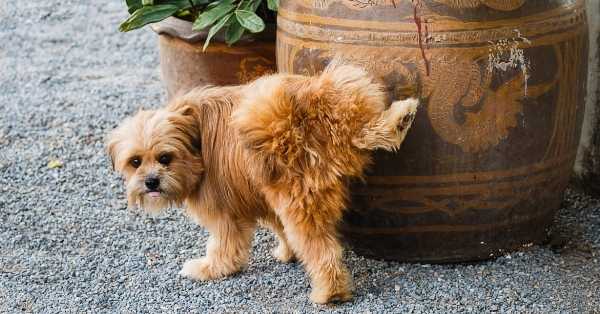
According to the Canine Urine Marking article published on Today’s Veterinary Technician – an official journal of the North American Veterinary Community (NAVC), urine marking behavior is especially prevalent in sexually intact male dogs when they reach sexual maturity.
This is their way of marking their territory, leaving a message for other dogs, and it most commonly happens when a male dog senses a female dog in heat nearby.
While urine marking in dogs is a natural and instinctive behavior, it can be problematic and frustrating for the dog owner when it is done inside the house. This is due to the more concentrated nature of the dog’s urine, which leaves behind a strong, potent smell.
4. Mounting
One of the most well-known and highly common sexual behaviors in dogs is mounting.
A sexually intact male dog can display mounting behaviors, which is natural. However, this can rise into a problem when he starts mounting other animals or people and does it frequently.
It is also important to note that mounting is done by small puppies as well, whey they are just a few weeks old, and this behavior is not sexual but rather playful.
Therefore, as the dog owner, you need to be able to differentiate between sexual mounting behavior and playful mounting behavior based on your dog’s age.
5. Thrusting/ Humping
The American Society for the Prevention of Cruelty to Animals (ASPCA) states that thrusting or humping is a form of sexual behavior exhibited by both male and female dogs when they reach sexual maturity.
Thrusting could be considered a form of masturbation, and dogs tend to thrust against objects, other animals, and also people. Some experts also believe that dogs might thrust as a practice for their future sexual encounters.
Interestingly, humping behavior is not limited to only sexually intact male dogs, but is also commonly seen in neutered or spayed male and female dogs.
6. Being Obsessed With Female Dogs
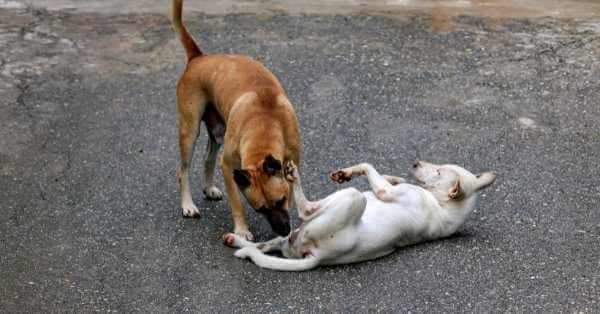
Another sign your male dog is interested in mating is that he will become very interested in the female dog’s vaginal secretions, in particular, the pheromones that the female dog emits.
If he has the opportunity to be near female dogs, he may start licking and sniffing around her genitals more than usual, and he may even try to mount her.
He may also get obsessed with a female dog in heat and circles this dog continuously in an attempt to “court” her. This obsession may cause the male dog to lose interest in everything else and only focus on following this female dog.
7. Whining Excessively
Dogs whine for many reasons, but if your male dog starts whining excessively when he’s around female dogs, it may be a sign that he’s ready to mate.
It will be easy to differentiate between the whining caused by general excitement and the whining caused by mating desires if you keep track of your dog’s behavior around female dogs in heat.
8. Lost of Appetite
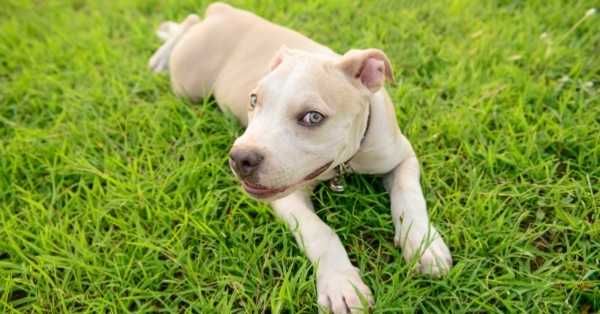
A decrease in appetite is also a sign that your male dog wants to mate. This is because he’s using all of his energy to try and find a female dog to mate with, and doesn’t have time or energy to eat.
Your dog may skip meals or only pick at his food when he’s in this state. You will find this very unusual especially if your dog is usually a voracious eater.
If you’re noticing any of these signs, it’s important to take steps to prevent your dog from mating with other dogs. And at the same time, be patient with your dog and continue to prepare his meals even though he may not eat it.
9. Be Aggressive To Other Male Dogs
If your male dog starts to get aggressive with other male dogs, it’s a sign that he’s feeling territorial and wants to mate, especially if there is a female dog in heat nearby.
He may start to growl, bark, and lunge at other dogs when they come near him to ward off the competition. This is his way of trying to assert his dominance over them so that he can mate with the female dog.
But is being aggressive always better?
One study suggests that female dogs show preference to mate with some males and resist others. In this study, female dogs actually do not prefer to mate with aggressive and physically powerful males. They view such behaviors as overwhelming and not even be described as “rape” when a dominant male copulate with an unwilling female dog.
10. Masturbation and Ejaculation
It is true that dogs can masturbate on their own and sometimes even lead to ejaculation when they are overly sexually excited. Dogs may hump objects or people as a way to release sexual energy, and this is more common in teenage dogs.
Male dogs can also ejaculate a white milky fluid and usually, the first few ejaculates will contain many unhealthy sperm. If your dog is masturbating excessively, you may want to consider letting him mate with a female dog.
These 2 activities can happen to both neutered and intact dogs, although it is less seen in neutered dog. It is still a behavior that should not be encouraged.
So, if you find your male dog showing flirtatious signs like licking, tail up, pawing, etc., along with mounting, thrusting, and other signs discussed above, understand that he is ready and wants to mate.
Also Read: What Happens If A Male Dog Doesn’t Mate?
10 Signs That A Female Dog Wants To Mate
A female dog experiences her first estrus when she is anywhere between 6 and 24 months old. Smaller breed dogs are known to experience the same sooner and large breed dogs later.
Depending on the female dog’s breed and size, she is likely to go into heat twice a year, once every six months.
If your female dog has no health concerns and is cleared by your vet for breeding, she will be ready for the same during her third heat cycle, as the third cycle would be her prime fertility time.
This is why breeders are advised to not start breeding during the first two heat cycles of a female dog. During the third cycle, her body, including her uterus, will be ready to grow and nurture babies, with all her hormones at their optimum levels.
When your female dog is in heat and ready to mate, the initial indications would be increased alertness, nervousness, and getting frenzied easily.
The hormonal changes in her body will lead to various behavioral changes, and you might also notice her initiating sexual contact with male dogs.
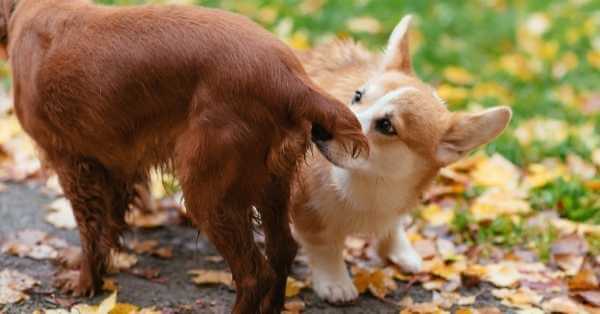
Here are some signs that your female dog wants to mate:
- Her vulva gets swollen, which typically happens during the first stage of her heat cycle – the proestrus.
- She will experience a bloody discharge from her vulva – proestrus.
- She is likely to start licking her genitals excessively – proestrus.
- She will be aggressive towards the male dogs that approach her for breeding – proestrus.
- She will hold her tail close to her body – proestrus.
- She will start urinating more frequently, which usually begins during the second stage of the heat cycle – the estrus.
- During this time, she will be less aggressive towards male dogs but might be more aggressive towards other females – estrus.
- She will have an enlarged vulva – estrus.
- Her bloody discharge is likely to have reduced – estrus.
- She will start approaching male dogs with her tail moved to the side – estrus.
Changes in Female Dog’s Behavior During Heat Cycle
During each stage of her heat cycle, your female dog will display a variety of behavioral changes.
Proestrus
During this first stage of the heat cycle, which lasts for about 9 days in most dogs, a female dog could display the following changes:
- Evident changes in her personality, which can be in two extremes. On one day, you might find her being too clingy and wanting to be close to you all the time, and the next day she may not want to be bothered.
- You are most likely to notice that she is starting to tuck her tail between her legs every time another dog tries to get near her. This is her way of protecting her vulva, as it will now be swollen and in a vulnerable state.
- During the initial few days of her heat cycle, a female dog could have a bigger appetite than usual, so you may have to increase the portions of her meals.
- The level of swelling of a dog’s vulva varies from one female to another. In fact, it could be different from one heat cycle to another as well.
Estrus
Estrus is the second stage of a female dog’s heat cycle, and it is during this phase that she will be at her fertile best. Her ovaries are starting to produce eggs, expecting fertilization, and she will now be more open to a male dog’s company.
- The bloody discharge that was bright red during the proestrus stage will now lighten.
- Her tail tucking behavior is no longer there, and she will now be happily welcoming male dogs to get to know her (by smelling, rubbing, licking, etc.). Beware: if there are no male dogs in close proximity, she might try to flee looking for one.
- The swelling of her vulva will be reduced by now, making it soft enough to smoothly accept penetration.
Diestrus
By this time, your female dog is out of her fertile period and nearing the end of her heat cycle. If mating was a success and she gets pregnant, this stage will continue until she gives birth.
- Her vulva will slowly get back to its original state, with no swelling, redness, or softness.
- Her vaginal discharge will also stop soon.
- The female will now be her original self in terms of social behavior – neither too aggressive nor grumpy.
Anestrus
Known as the inactive stage of a female dog’s heat cycle, anestrus is the longest phase and lasts until the dog’s next active heat cycle or proestrus.
How To Calm A Male Dog In Heat?
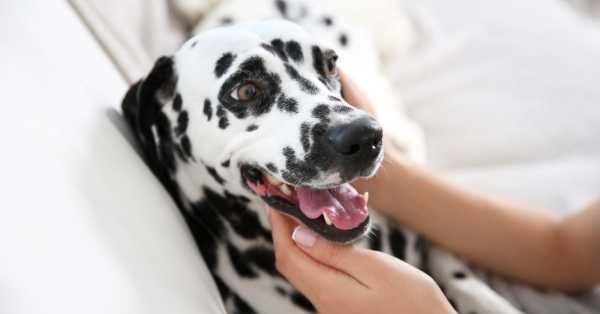
For owners of male dogs, here are a few tips to keep him calm when he shows signs of wanting to mate:
- Exercising your male dog regularly is a great way to keep him calm and distracted from his mating thoughts. Follow a regular walking schedule, and increase the distance depending on your dog’s breed. This will help utilize all his active energy, so he remains calm when he gets home.
- Give his mind some exercise as well. Play his favorite game with him or introduce him to new games. Hide his favorite treat in different areas around the house and make him find them. Introduce some new toys to keep him occupied.
- Whenever he tries to mount, thrust, or display other forms of sexual behavior, divert him by saying NO or STOP in a firm voice. You can also call his name, throw his favorite toys, give him treats, etc. to change his mind.
How To Calm A Female Dog In Heat?
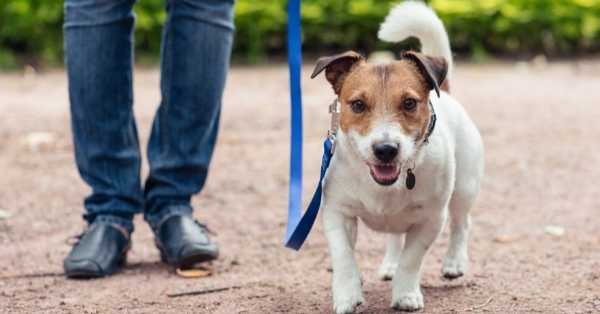
If you have a female dog and she is experiencing her first heat cycle, here are a few things you can do if you are not interested in breeding or don’t want her to mate:
- When you know that your female dog is in heat, it is best to keep her indoors because male dogs in your neighborhood can easily smell her scent and would jump fences and dash doors to get to her.
- Depending on where you are keeping her, have her on a leash. Your dog might be the most obedient canine you’ve ever seen; but, when she is in heat, her hormones will take over and she will have no control over her actions. To stop her from running away, keep her on a leash.
- If you are new to this entire heat cycle or mating scenario and concerned that your female dog might be in trouble health-wise, do not hesitate to consult your vet.
- Make sure that your dog has her ID tag and the information on it is up-to-date. Do the same with her microchip, if she has one. This will be a lifesaver in case your canine chooses to run away.
If you have both male and female dogs in the house, you need to keep them in separate rooms until the female’s heat cycle is over. Play with them and exercise them separately.
Neutering and Spaying
Neutering, also known as castrating, is a procedure for male dogs, in which their testicles will be removed by surgery.
Spaying, on the other hand, is the procedure for female dogs, which involves removing their uterus and ovaries, or just ovaries in some instances. Since this procedure is more elaborate and complicated than neutering, it is also more expensive.
While some dog owners hesitate to have their pets neutered or spayed, vets, researchers, and experts highly recommend the procedures for many good reasons.
According to research, neutering adult male dogs is known to reduce roaming in 90% of the dogs, and also other behaviors like mounting, urine marking, and fighting.
Furthermore, a study conducted by the University of Georgia revealed that neutering male dogs and spaying female dogs extended their life expectancy significantly.
Other Procedures
Apart from neutering and spaying, there are surgical alternatives to those procedures, which, as recommended by the American Veterinary Medical Association (AVMA), are the following:
- Vasectomy: involves removing only the vas deferens – the tube that transports sperm from the testes. This means that the male dog’s testicles will remain, and he will still have breeding instincts.
- Hysterectomy: involves removing the uterus and part of the female dog’s fallopian tubes. In this case, her ovaries will remain but she will not be able to reproduce.
- Ovariectomy: involves removing the ovaries and not the uterus.
To make an informed decision, you can consult your veterinarian and discuss the different options available. Based on your dog’s health condition, your vet will be able to recommend a few procedures that you can choose from.

